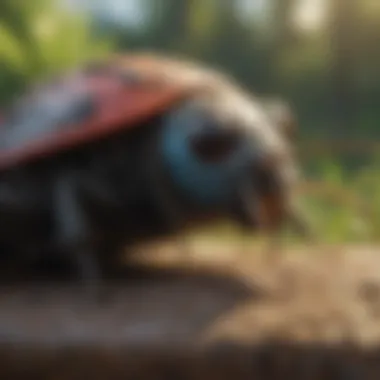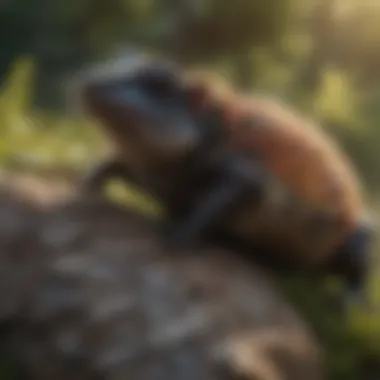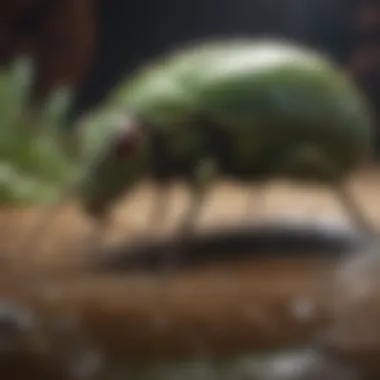Unveiling Innovative Pest and Wildlife Management Strategies


Preventive Pest Control Strategies
When it comes to pest control, prevention is key to maintaining a pest-free environment. Taking proactive measures to safeguard your home against potential intruders can save you time, money, and stress in the long run.
House Exterior Protection
Ensuring your house's exterior is well-maintained is the first line of defense against pests. Sealing cracks and openings with weatherproof sealant can prevent insects and rodents from finding their way into your home. Additionally, clearing debris such as fallen leaves and woodpiles eliminates hiding spots for pests.
Yard Maintenance
Maintaining a pest-free yard involves regular care routines such as mowing the lawn, trimming bushes, and removing standing water sources. These activities not only enhance the aesthetic appeal of your outdoor space but also reduce the attractiveness of your yard to potential pests.
Indoor Cleanliness
Keeping the interior of your home clean and clutter-free is essential in pest prevention. Implementing expert cleaning techniques, such as vacuuming regularly, sealing food containers, and disposing of garbage promptly, can significantly deter pests from taking up residence in your living spaces.
Garbage Disposal
Proper waste disposal is crucial in preventing pest infestations. Utilizing efficient methods like securing garbage bins with tight-fitting lids and disposing of food scraps in sealed bags eliminates food sources that can attract pests, thereby reducing the risk of unwanted intruders.
Other Pest Prevention Strategies
Beyond the fundamental preventive measures, there are innovative ways to fortify your home against pests. Implementing strategies like installing mesh screens on windows and doors, utilizing ultrasonic repellers, and incorporating natural repellents can offer additional layers of defense against pest invasions.
Introduction
In this detailed exploration of Pest and Wildlife Management Strategies, we unveil the intricacies and critical importance of combating issues related to pests and wildlife. Understanding the delicate balance within ecosystems is paramount to ensuring the sustainable coexistence of all living beings. By laying the foundation through this introduction, we aim to shed light on the complexities and challenges faced in managing pests and wildlife effectively.
Pests and wildlife play pivotal roles in shaping ecological systems. From causing ecological disruptions to posing risks to agricultural productivity and public health, their impact resonates across various facets of human life. Recognizing the need to address these challenges proactively, this article ventures into innovative solutions and sustainable practices that aim to mitigate these issues.
Moreover, beyond the adversities posed by pests and wildlife, there exist intricate relationships between predators and prey. The dynamics of population control and food chain interactions underscore the delicate web of life within ecosystems. By delving into these nuances, we lay the groundwork for a comprehensive understanding of the roles predators and prey play in maintaining equilibrium within natural ecosystems.
Throughout this exploration, we will navigate through the realms of biological control methods, integrated pest management techniques, wildlife conservation strategies, and technological advancements in pest control. By unraveling these strategies, we aim to equip readers with a holistic approach to addressing pest and wildlife management challenges, culminating in a harmonious cohabitation of humans and wildlife.


Understanding Ecosystem Dynamics
Understanding the intricate balance of ecosystems is crucial in the realm of pest and wildlife management. This section delves into the pivotal role that ecosystem dynamics play in shaping habitats and the interactions between organisms. By comprehensively examining how various factors impact ecosystems, we gain valuable insights into devising effective strategies for managing pests and wildlife.
Impact of Pests and Wildlife
Ecological Disruption
Ecological disruption is a critical aspect to consider in understanding ecosystem dynamics within the context of pest and wildlife management. It encompasses the far-reaching consequences of invasive species, habitat destruction, and disruption of natural processes. The unique feature of ecological disruption lies in its ability to destabilize entire ecosystems, leading to cascading effects on biodiversity and ecological integrity. While addressing ecological disruption poses challenges, managing this aspect effectively is essential for maintaining ecosystem stability.
Agricultural Damage
Agricultural damage is a key factor influenced by pests and wildlife, impacting the overall ecosystem dynamics. This aspect focuses on the detrimental effects of pests on agricultural productivity, leading to economic losses and food insecurity. The distinctive characteristic of agricultural damage is its direct implication on human livelihoods and food resources. While addressing agricultural damage requires strategic interventions, mitigating its effects is paramount for ensuring sustainable agricultural practices.
Public Health Concerns
The interplay between pests, wildlife, and public health is a significant aspect that necessitates attention within ecosystem dynamics. Public health concerns center around zoonotic diseases, allergens, and physical harm posed by pests and wildlife to human populations. The essence of public health concerns lies in the potential risks these pose to human well-being and community health. Effectively managing public health concerns requires a holistic approach encompassing surveillance, prevention, and control measures for safeguarding public health.
Role of Predators and Prey
Examining the dynamic relationship between predators and prey elucidates the intricate web of interactions within ecosystems. Understanding how predators regulate prey populations and contribute to ecosystem balance is fundamental in formulating efficient pest and wildlife management strategies.
Balancing Population Dynamics
Balancing population dynamics is a crucial aspect in maintaining the equilibrium within food chains and ecosystems. This component focuses on the vital role predators play in controlling prey populations, preventing overpopulation, and promoting biodiversity. The key characteristic of balancing population dynamics lies in its ability to regulate species abundance and foster ecological resilience. While managing population dynamics requires a nuanced approach, ensuring a balanced predator-prey dynamic is essential for preserving ecosystem health.
Food Chain Interactions
Food chain interactions underscore the complex relationships between different trophic levels and species within ecosystems. This aspect highlights how energy flows through ecosystems, influencing species interactions and population dynamics. The unique feature of food chain interactions is the transfer of energy and nutrients across trophic levels, shaping the structure and function of ecosystems. Understanding and managing food chain interactions are essential for maintaining ecosystem stability and biodiversity.
Innovative Pest Management Techniques
In the realm of pest and wildlife management, Innovative Pest Management Techniques stand as a beacon of advancements and progress towards sustainable solutions. At the core of this article, Innovative Pest Management Techniques play a pivotal role in addressing challenges related to pest control and ecological balance. By embracing novel approaches and methods, this section delves into the intricacies of managing pests with efficiency and ecological mindfulness.
Biological Control Methods


Introduction of Natural Predators
Introduction of Natural Predators introduces a groundbreaking concept in pest management by harnessing nature's own mechanisms to regulate pest populations. The employment of natural predators serves as a cornerstone in maintaining a balanced ecosystem by leveraging the predator-prey dynamics. The allure of utilizing natural predators lies in their innate ability to target specific pest species, offering an environmentally friendly and sustainable pest control option within the context of this article.
Utilization of Microbial Agents
Utilization of Microbial Agents emerges as a cutting-edge approach in pest management strategies by harnessing the power of beneficial microorganisms to combat pest infestations. One of the key characteristics of this method is its targeted action on pests while minimizing harm to non-target organisms. The unique feature of microbial agents lies in their ability to provide effective pest control while posing minimal risks to the environment, making them an advantageous choice for integrating sustainable practices within this article.
Integrated Pest Management
Combining Cultural and Biological Practices
Combining Cultural and Biological Practices signifies a holistic approach to pest management that amalgamates traditional cultural methods with modern biological interventions. This blend of practices aims to create a harmonious pest management system that is both effective and environmentally sensitive. The key characteristic of this approach is its comprehensive nature, which addresses pest issues from multiple angles, showcasing its viability as a popular choice within the context of this article.
Reducing Reliance on Chemical Pesticides
Reducing Reliance on Chemical Pesticides underscores the importance of moving away from traditional chemical-based pest control towards sustainable alternatives. This shift not only benefits human health and the environment but also fosters long-term pest management strategies that are both effective and eco-conscious. The unique feature of this approach lies in its ability to mitigate the negative impacts of chemical pesticides while maintaining pest control efficacy, making it a beneficial choice for promoting sustainability within this article.
Wildlife Conservation Strategies
Wildlife conservation strategies play a pivotal role in ensuring the preservation of biodiversity and the delicate balance of ecosystems. In the context of this article, wildlife conservation encompasses a range of crucial elements aimed at mitigating threats to various species and their habitats while promoting sustainable coexistence between wildlife and human activities. By emphasizing the significance of wildlife conservation strategies, this section sheds light on the measures necessary to safeguard the environment and the diverse wildlife populations.
Habitat Preservation
Protected Areas Designation
Protected areas designation stands out as a cornerstone of wildlife conservation strategies. These specially designated areas serve as sanctuaries for diverse flora and fauna, providing essential habitats for numerous species to thrive. The key characteristic of protected areas designation lies in their legal protection, ensuring that these ecosystems are shielded from detrimental human activities. This safeguarding is a beneficial choice for this article as it underscores the importance of preserving undisturbed habitats for wildlife survival. One unique feature of protected areas designation is the guarantee of habitat protection, which prevents habitat loss and fragmentation. While advantageous in maintaining biodiversity, one potential disadvantage lies in the limitations imposed on human activities within these areas, which can sometimes lead to conflicts between conservation efforts and human needs.
Restoration of Degraded Habitats
The restoration of degraded habitats plays a vital role in wildlife conservation strategies by reviving ecosystems that have been compromised due to human intervention or natural disasters. This aspect contributes significantly to the overall goal of reestablishing sustainable habitats for various species. The key characteristic of habitat restoration lies in its ability to enhance biodiversity and ecosystem resilience by restoring vital ecological processes. This approach is a popular choice for this article as it highlights the importance of actively reversing environmental damage to support wildlife populations. A unique feature of habitat restoration is the active assistance in accelerating ecological recovery, which can lead to increased species richness and ecosystem functions. Despite its advantages in habitat improvement, a potential disadvantage may involve the high costs and extensive effort required for successful habitat restoration.
Human-Wildlife Conflict Resolution
Non-Lethal Deterrents


Non-lethal deterrents form a critical component of human-wildlife conflict resolution strategies. These deterrents aim to deter wildlife from human-inhabited areas without causing harm to the animals. The key characteristic of non-lethal deterrents lies in their focus on peaceful coexistence between humans and wildlife, promoting conflict resolution through non-violent means. This approach is a beneficial choice for this article as it emphasizes humane practices in addressing conflicts between wildlife and human interests. A unique feature of non-lethal deterrents is their emphasis on minimizing harm to wildlife while effectively preventing property damage or threats to human safety. However, a potential disadvantage may arise if these deterrents are not consistently applied or if wildlife becomes accustomed to their presence, reducing their effectiveness over time.
Community Engagement Programs
Community engagement programs are indispensable for fostering effective communication and cooperation between human communities and wildlife conservation efforts. These programs involve educating and involving local communities in conservation initiatives to cultivate mutual understanding and support for wildlife protection. The key characteristic of community engagement programs lies in their ability to empower communities to take an active role in wildlife conservation, enhancing local ownership of conservation efforts. This aspect is a popular choice for this article as it underscores the importance of grassroots involvement in addressing human-wildlife conflicts and promoting coexistence. A unique feature of community engagement programs is their capacity to build trust and cooperation between stakeholders, leading to more sustainable and holistic approaches to wildlife conservation. Despite their advantages in promoting community stewardship, a potential disadvantage may involve the challenges of maintaining long-term community participation and commitment to conservation activities.
This comprehensive discussion on wildlife conservation strategies, habitat preservation, and human-wildlife conflict resolution provides a thorough exploration of the multifaceted approaches essential for protecting wildlife and promoting harmonious interactions between humans and natural ecosystems.
Technological Advancements in Pest Control
In the realm of pest control, embracing technological advancements is crucial for effectively managing and mitigating pest issues. This section explores the pivotal role that technology plays in enhancing pest control strategies within the broader context of ecosystem management and sustainability. By incorporating cutting-edge technologies, such as remote sensing applications and precision agriculture techniques, pest control efforts can be more precise, efficient, and environmentally friendly. Technological advancements not only streamline pest monitoring and management processes but also contribute to minimizing the adverse impacts of conventional pest control methods on ecosystems.
Remote Sensing Applications
Monitoring Pest Movements:
Monitoring pest movements through remote sensing applications revolutionizes pest control by providing real-time data on pest populations' locations and movements. This proactive approach allows for early detection of pest outbreaks, enabling swift and targeted intervention strategies. The key characteristic of monitoring pest movements lies in its ability to offer granular insights into pest behavior, facilitating informed decision-making regarding pest control measures. The unique feature of this method is its non-invasive nature, reducing the need for manual monitoring and ensuring a more sustainable and cost-effective pest management approach. While advantageous in enhancing pest control efficiency, it may face limitations concerning the resolution of data and the interpretation of complex pest behavior patterns.
Mapping Infestation Areas:
Mapping infestation areas leverages remote sensing technology to create detailed spatial representations of pest infestations across different landscapes. By visually identifying areas of high pest activity, mapping infestation areas aids in identifying hotspots that require targeted control measures. The key characteristic of this approach lies in its ability to visualize pest distribution patterns accurately, enabling resource allocation and intervention strategies optimization. The unique feature of mapping infestation areas is its ability to track pest movement trends over time, facilitating predictive modeling of pest outbreaks. While beneficial in enhancing precision in pest control, challenges may arise in accurately interpreting data due to factors like environmental variables and spatial resolution limitations.
Precision Agriculture Techniques
Targeted Pesticide Application:
Precision agriculture techniques, specifically targeted pesticide application, entail the precise delivery of pesticides based on localized pest infestation levels and crop needs. This methodology aims to optimize pesticide efficacy while minimizing environmental impacts associated with broad-spectrum spraying. The key characteristic of targeted pesticide application is its site-specific nature, allowing for precise targeting of pest populations while reducing pesticide usage overall. The unique feature of this technique is its integration of data-driven decision-making, incorporating factors like pest density and distribution for tailored pest control strategies. While advantageous in reducing pesticide wastage and minimizing non-target effects, challenges may arise in implementing variable-rate application systems and ensuring accurate pest monitoring data.
Automated Monitoring Systems:
Automated monitoring systems are revolutionizing pest control by integrating sensors and data analytics to autonomously track pest populations in agricultural environments. By continuously monitoring pest activity and environmental conditions, automated systems enable early detection of pest outbreaks and real-time intervention responses. The key characteristic of automated monitoring systems is their ability to provide instant alerts regarding pest presence, facilitating prompt decision-making for control measures. The unique feature of these systems is their ability to streamline data collection and analysis processes, enhancing the efficiency of pest monitoring programs. While advantageous in enhancing monitoring accuracy and timeliness, challenges may emerge in system maintenance, data security, and initial setup costs.
Conclusion
This article has underscored the significance of implementing innovative strategies that prioritize the balance of nature while effectively managing pest and wildlife populations. By delving into topics such as biological control methods, integrated pest management, wildlife conservation strategies, and technological advancements in pest control, we have gleaned a profound understanding of the multifaceted approaches that can be employed to mitigate human-wildlife conflicts and preserve biodiversity.
The cohesive narrative presented in this article stresses the importance of proactive measures in pest and wildlife management. It highlights the need for a holistic approach that takes into account the intricate interplay between various species, ecosystems, and human activities. By embracing a comprehensive strategy that integrates biological, cultural, and technological interventions, stakeholders can foster resilient ecosystems and minimize adverse impacts on agriculture, public health, and conservation efforts.
Moreover, the emphasis on sustainable practices throughout this exploration echoes the growing recognition that traditional reliance on chemical pesticides poses risks to environmental and human health. By advocating for eco-friendly solutions and promoting habitat preservation, community engagement, and precision agriculture techniques, this article encourages a paradigm shift towards more ecologically conscious pest and wildlife management practices.
In essence, the conclusion of this article serves as a call to action for individuals, communities, and policymakers to embrace a proactive and adaptive approach towards managing pest and wildlife populations. By blending scientific knowledge with innovative technologies and sustainable practices, we can forge a path towards coexistence that safeguards biodiversity, enhances agricultural sustainability, and fosters healthier ecosystems for current and future generations.



